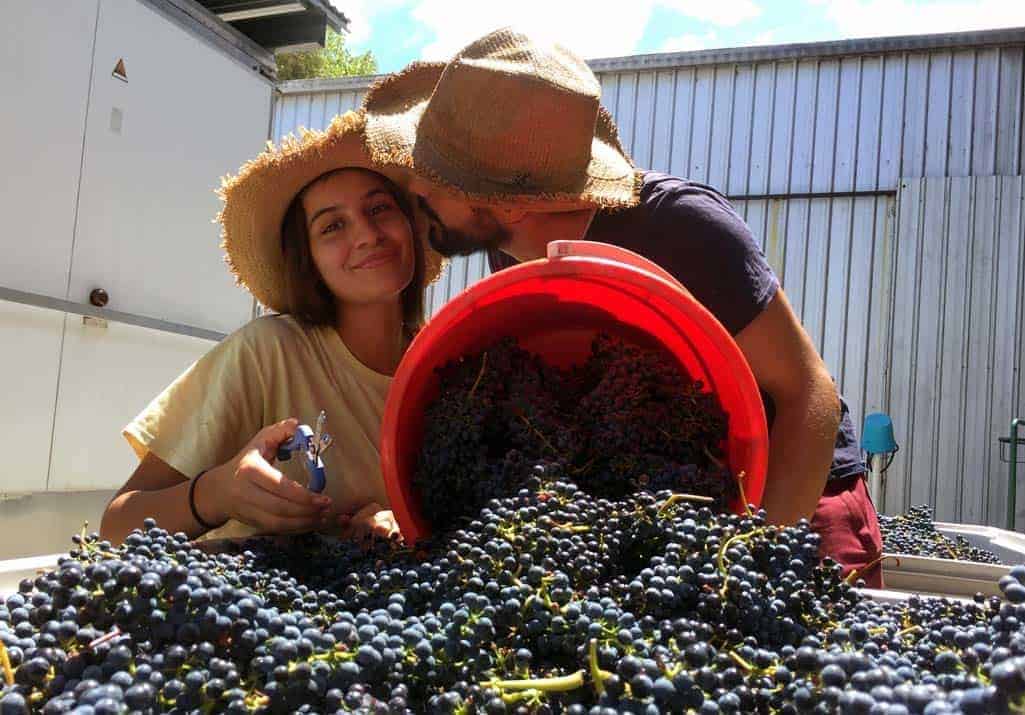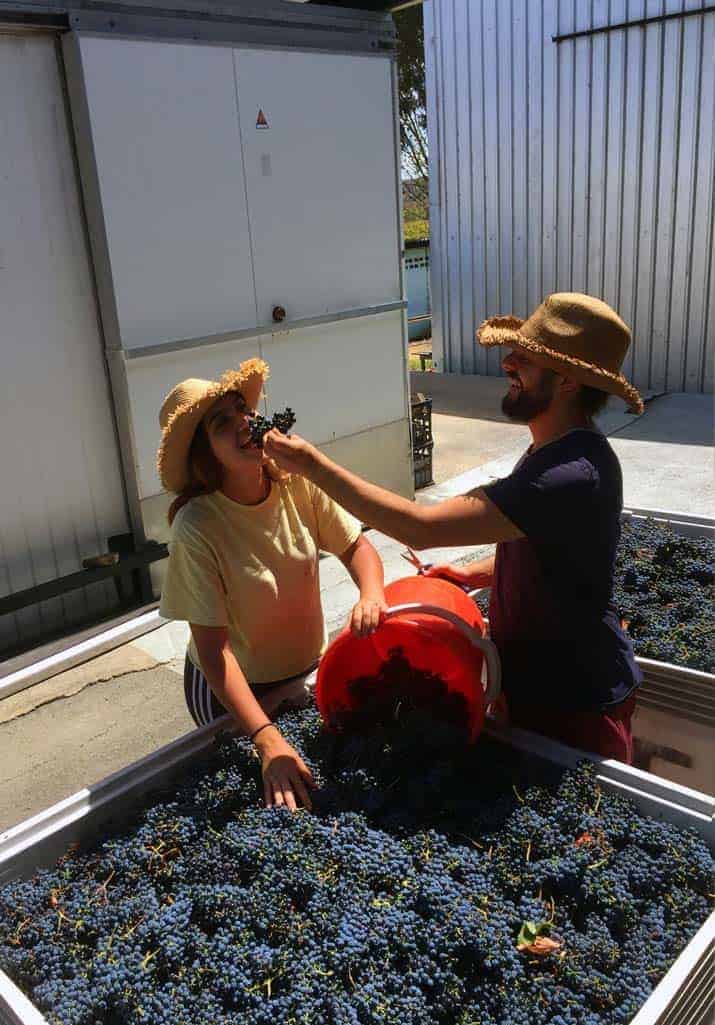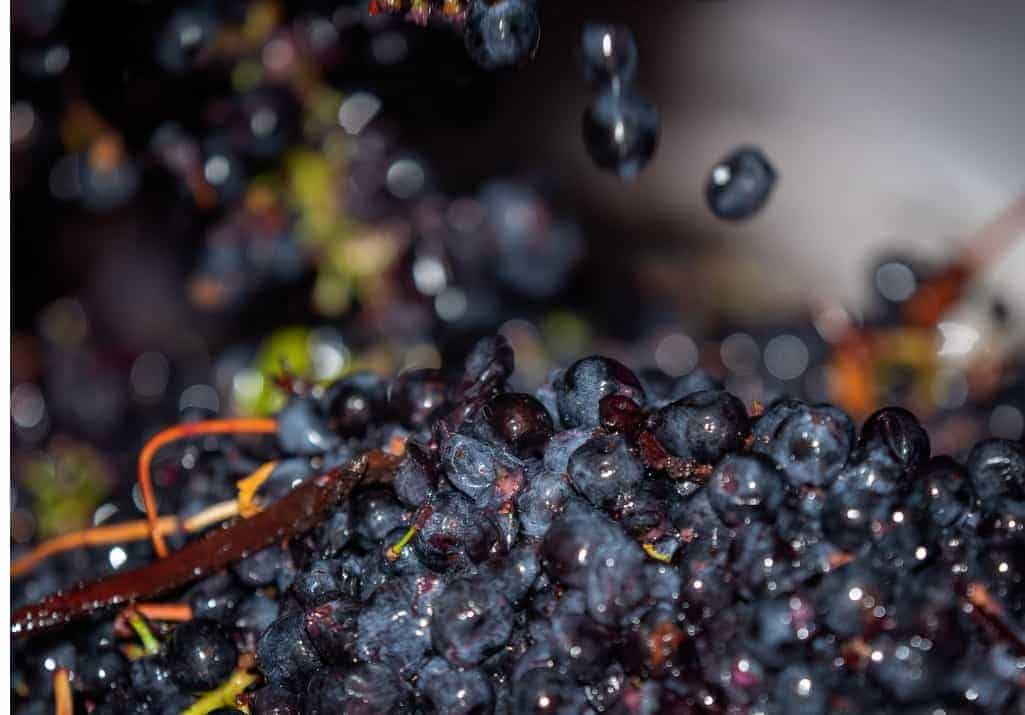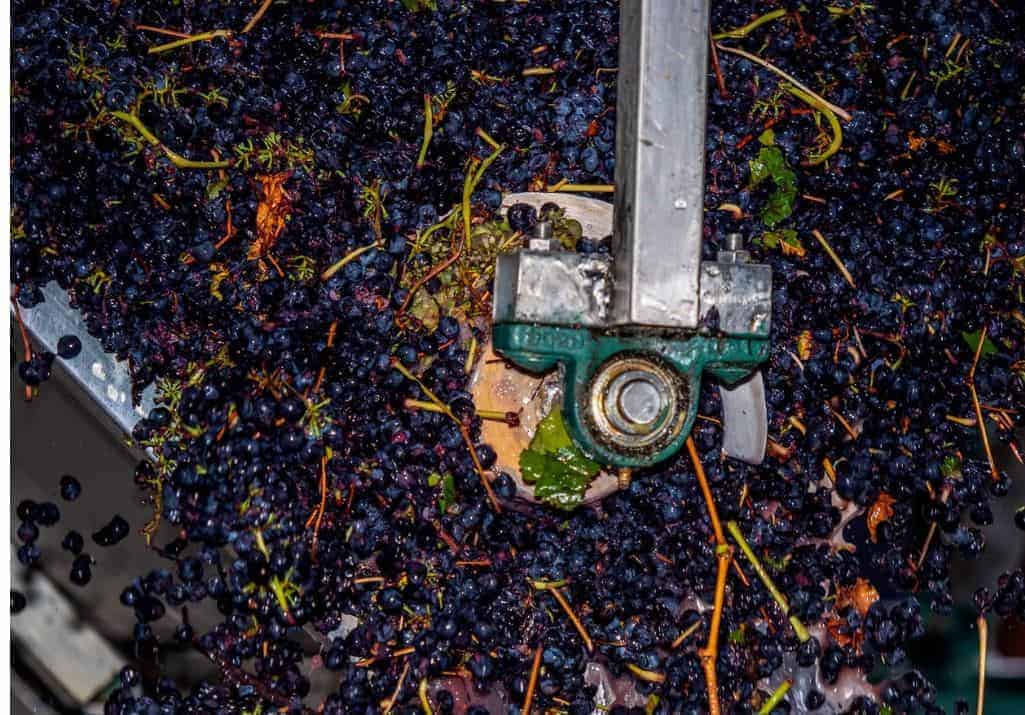Queensland’s oldest family-owned and -operated winery future-proofed its reputation for world-class Shiraz by planting 5000 Shiraz plants next to the Opera Block vineyard at Ballandean Estate last week.
Fourth-generation vigneron Leeanne Puglisi-Gangemi says,
Ballandean Estate’s award-winning single vineyard premium Shiraz is sourced from the Opera Block’s oldest vines, planted in 1968, some of the oldest in Australia.
Fifty years on, these vines are bearing incredible fruit. However, the yield is considerably reduced, down to one tonne an acre. Optimal yield for production is two tonnes an acre.
Dad (father of Queensland wine Angelo Puglisi) was itching to try out a new Shiraz clone on a block that we had lying fallow for the last five years, once home to cabernet vines.
Shiraz is our signature varietal, and we wanted to ensure our ability to meet the market in years to come.
The new vines will be bearing fruit next season, however, we will be knocking the first few yields off the vine to establish a stronger root system. By 2025, we should be seeing the first harvest.
Such a brilliant week in the vineyard, with bud burst underway and all hands on deck! We’ve had Dad, myself, my sister Robyn, vineyard manager Robyn Robertson, Tash Banbury, Peter Wade, plus Jason Costanzo and his vineyard team from Golden Grove Estate getting their hands dirty with the planting, which took five days,”
says Ms Puglisi-Gangemi.
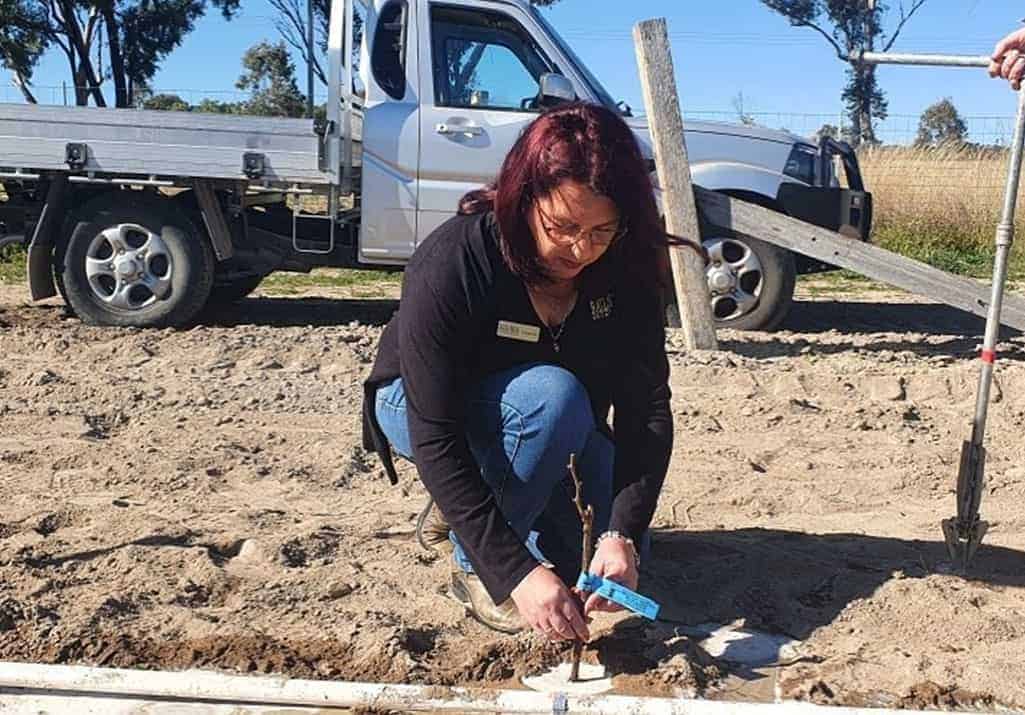
In the next few months Ballandean Estate will be releasing its much-anticipated 50th vintage of Shiraz.
“Our cool climate Shiraz is a vinicultural jewel. 2018 was an exceptionally low-yielding year—we have produced only 150 dozen of the Opera Block Shiraz for this vintage. The long ripening season and cold nights have delivered a delicate cool climate Shiraz, intense purple with concentrated berry fruits. We bottled this beauty back in 2019.”
For all media enquiries please contact:
Robyn Puglisi-Henderson or Leeanne Puglisi-Gangemi
Ph: (07) 4684 1226
After opening its doors ten days ago to interstate visitors, Ballandean Estate Wines is reporting a minimal impact on visitation. Queenslanders continue to embrace a wine country getaway as visitors pour in from the Sunshine Coast and Brisbane primarily.
Leeanne Puglisi-Gangemi, fourth-generation vigneron at Queensland’s oldest family-owned and -operated winery on the Granite Belt, says,
Like all businesses along the NSW-QLD border, we’ve been intrigued as to how the lifting of border restrictions will impact our business. Before Victoria’s COVID situation escalated, we were anticipating an influx of grey nomads.
Since the borders re-opened, we have hardly any visitors identify as from New South Wales. And yes, we’ve been asking! Everyone who comes through our cellar door is required to sign in under our COVID-safe venue plan.
Up until the last few weeks, most of our visitors have been return visitors that know and love the Granite Belt for all of its natural beauty, fine wine, abundant gourmet delights, quirky charms and country hospitality.
What we have been thrilled to discover is that a huge proportion of our Queenslander visitors are here on the Granite Belt for the first time. For so many Queenslanders, the Granite Belt has been sitting on their ‘One Day’ wish list. Now it seems that has rapidly changed to ‘This Year’ and ‘Good to Go!’
Until you experience the glory of the Granite Belt in person, it can be hard to compete with the abundance of destinations within an hour of Brisbane and the Gold Coast.
If the last few weeks are anything to go by, the Granite Belt is set for its best spring season yet! This has traditionally been a quieter time of year. However, we have tastings booked up online through to September, and accommodation house are reporting unheard-of occupancy rates.
I expect that our Tenterfield locals are staying put to avoid the border patrol, and that our southern visitors are either staying put or venturing further north chasing the sun after months of border restrictions.
We hope that Queensland continues to remain COVID-safe and that we can maintain then improve upon the current level of restriction for venues. I think that people are really understanding the importance of hand hygiene, social distancing and contact tracing at venues.
Our cellar door hand Elijah Smith made me a hand sanitiser holster to help me keep safe as I serve tastings to over 500 people each weekend.
Ms Puglisi-Gangemi was instrumental in successfully lobbying the Office of Liquor and Gaming for some easing of restrictions and is an active member of the Queensland Wine Industry Association .
How to make sure you book an unforgettable wine tasting experience at Ballandean Estate
- We’d love it if you could book your tasting in advance online or over the phone. Our peak times are over lunch and on Saturdays, and we highly recommend booking first.
- If you want to come in on the day and have not yet booked, we ask that you pick up the phone and call us on (07) 4684 1226 so that we can fit you in.
- Walk-ins are always welcome, keep your beanie handy as we could be wine-tasting under the pergola in the winter sun if there is an overflow of people.
ENDS
For all media enquiries please contact: Robyn Puglisi-Henderson or Leeanne Puglisi-Gangemi
Ph: (07) 4684 1226 Leeanne@ballandeanestate.com, Robyn@ballandeanestate.com 354 Sundown Rd Ballandean 4382 www.ballandeanestate.com
Welcome to Ballandean Estate, Queensland’s oldest family owned and operated winery. Our family has been making wine on our Granite Belt estate since 1932, and we would love to share our estate grown and made wines with you. This year we are celebrating 50 years of Shiraz plantings in our high altitude vineyard and our 30th vintage of Semillon Sauvignon Blanc. As a multi-awarded 4.5-star winery, Ballandean Estate has an excellent range of mainstream and alternative wines that showcase our cool climate and granite terroir with elegance—just marvellous matched with Queensland’s outstanding produce.
Granite Belt winery operators Leanne Puglisi-Gangemi of Ballandean Estate and Warren Smith of Pyramid Road Wines have a starring role in Tourism Queensland’s latest campaign, It’s a beautiful place to holiday here.
#HolidayHereThisYear
Fourth-generation vigneron and regional tourism ambassador Leanne Puglisi-Gangemi says,
It is just so good to see cellar doors from the Granite Belt featured on this video!
“A lot of the time Queensland promotions are beach-centric, but we have such diversity on offer. From cool climate wineries, gourmet food trails, country hospitality, the Outback, and the world’s oldest surviving tropical rainforest—Queensland is so much more than the reef and the beach. It’s a beautiful place for a wine holiday here!
Leanne Puglisi-Gangemi
Quick action sees Granite Belt wineries enjoy a starring role
Robyn Puglisi-Henderson, sister and Ballandean Estate business manager says,
Warren and I had to move quickly on this! TQ sent out the invite on Friday, and we had to submit video footage shot on our phones that day for editing.
“We’ve joined Robert Irwin and a host of Queensland tourism operators to produce a video which will be used across social platforms to tell Australians that Queensland is ‘a beautiful place to holiday here this year’ and invite them to visit.
“It’s part of a $2 million dollar campaign showcasing to Australians why Queensland is ‘a beautiful place to holiday here this year‘, and builds on Tourism Australia’s campaign launched in late January in response to the bushfires.”
Robyn Puglisi-Henderson
You can view the video here: https://www.queensland.com/holidayhere
If you are sharing the video, make sure you use hashtags #HolidayHereThisYear and #thisisqueensland in your post.
Ballandean Estate has a rich history of empowered women in wine. Leeanne Puglisi-Gangemi was recently voted onto the Winemaker’s Federation board, and is Queensland’s first female voice and vote.
At just 19 years of age, estate matriarch and wine pioneer Mary Puglisi visualised opening a cellar door and being the catalyst for Queensland’s Barossa and Hunter Valley on the Granite Belt with husband Angelo Puglisi. She has spent over 50 years looking after tourists and has won the prestigious Samuel Basset award for her contribution to the Queensland wine industry.
Angelo’s mother Josephine was a true Australian pioneer and business woman. Arriving in Australia from Sicily at just 12 years of age, she went on to build the foundation of Ballandean Estate with her father and husband over four decades. She stared down the Australian army demanding to put her husband and father in internment camps and surrender of farm machinery during World War 2, and instead, she negotiated a deal to supply their crops to feed the Army as an alternative. Inspirational!
Ballandean Estate’s Business and Export Manager Robyn Puglisi-Henderson has developed the export trade from zero to 20% of our business turnover in just five years, and has opened up our export trade to China, where there is significant demand for our premium reds. They just love our Shiraz!
Meet our new vineyard manager Robyn Robertston
Ballandean Estate continues to break new ground with the appointment of a female vineyard manager, Robyn Robertson, former vineyard managed at Sirromet Wines. She brings over 30 years of viticultural expertise to the estate, and has spent her entire life on the land at Ballandean.
I am thrilled to be at Ballandean Estate, the Puglisis have welcomed me into their family. When I heard that there was an opening, the opportunity to learn in the presence of Queensland’s father of wine Angelo Puglisi was just too good to pass up.
Robyn Robertston
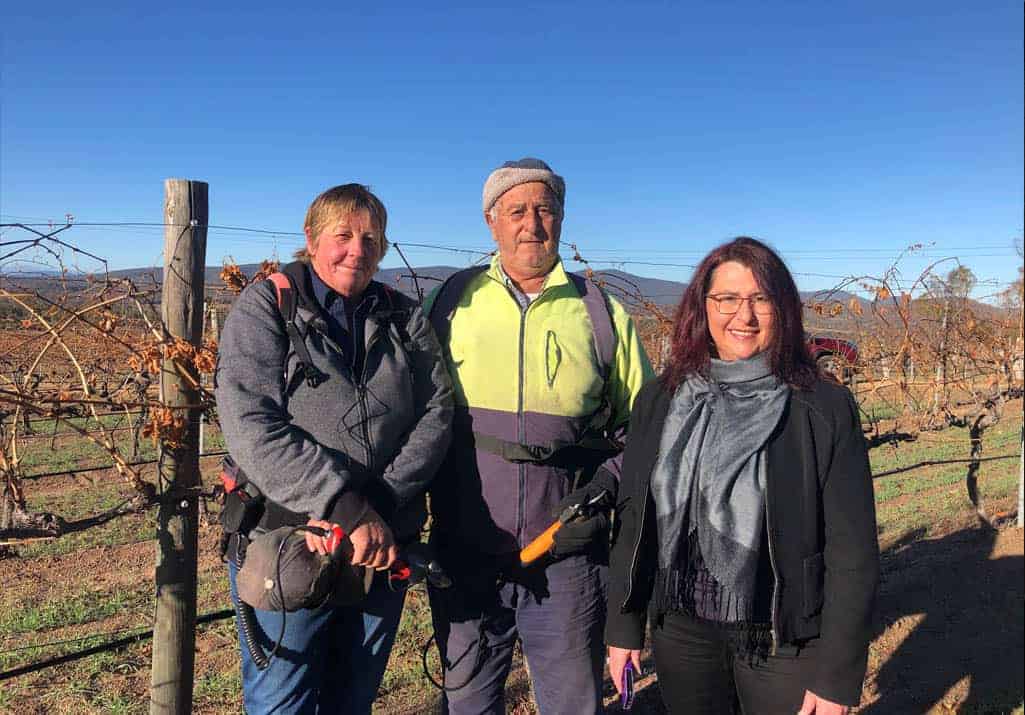
Granite Belt wine pioneers
Twisted Gum Wines owner Michelle Coelli has been an outstanding support to the local industry. She’s great to talk to, and runs monthly farm walks at different vineyards. Sue Smith from Pyramid Wines is another Granite Belt woman in the industry I admire.
Robyn Robertston
Why Robyn made the move from Sirromet to Ballandean Estate
Sirromet’s founder Tony Morris was really supportive of the move across to Ballandean and the chance for me to pursue my viticultural passion. One of the Sirromet properties I managed was my family property. I’ve worked on that property for over 20 years, and it was once our family orchard.
Nurturing Ballandean Estate’s Strange Birds™ was another drawcard, as the grapes at Sirromet are mainly traditional varieties. Fiano, Saperavi, Malbec, Durif, Tempranillo, Viognier … so many new challenges! I am most excited about the Durif 2020 vintage—it is such a temperamental Strange Bird™ , as it produces a heavy crop. If we don’t prune enough now, it will over-fruit. Given the drought conditions, it is critical that we prune hard to ensure a low yield of high quality.
Every day is different at Ballandean Estate—I could be pruning, tasting fruit, showing a tour group through our vines, maintaining irrigation lines or running harvest teams. I spend a lot of time with Angelo on the vineyards. Such a privilege to work with a master viticulturist. It is in his blood and mine.
Robyn Robertston
Robyn came on board mid-vintage and experienced a baptism of fire in an incredibly challenging season, with the Girraween bushfires blazing. Her influential position is made even more remarkable when despite gender-equal enrolments in wine and viticulture courses, women make up less than 10 per cent of the wine industry workforce, according to a large-scale Australian study by the Curtin Graduate School of Business, Women in top roles in the wine industry: Forging ahead or falling behind? Representation of women in leadership and senior roles is even smaller.
ENDS
For all media enquiries please contact:
Leeanne Puglisi-Gangemi or Robyn Puglisi-Henderson
Ph: (07) 4684 1226
Love is in the air at Ballandean Estate. Meet French lovebirds Afef and Thomas!
Ballandean Estate’s harvest season has been sweetened by the addition of honeymooning French couple Afef Idoudi (24) and Thomas Relizani (28), who have spent the last few weeks hand-picking much of Ballandean Estate’s fruit for the season.
Vineyard valentines
Our vineyard valentines hail from Nice in the south of France, and have been honeymooning in Australia since their late November wedding.
“Travelling the east coast of Australia is our lifelong dream, and we are lucky enough to be doing this for the next two years. Thomas and I are both nature-lovers. This is our first job in Australia, and we feel so blessed to be helping the Puglisi family bring their fruit in with tender loving care.
The Granite Belt is such an incredible food bowl—grapes, strawberries, tomatoes, lettuces, and all of the beautiful fruit orchards. Such abundance! We hope to spend several months here working on the land,”
says Afef Idoudi.
People, place and passion
Estate manager Robyn Puglisi-Henderson says.
“We just love giving these young people the opportunity to experience harvest, to share our people, place and passion. This year we’ve had 15 backpackers help us alongside our local crew. We get a range of nationalities, predominantly French, Italian and German this season.
“Our local harvesting office makes it so easy to engage with these adventurers. They come from such diverse backgrounds. Thomas is a tailor at home in France, he has offered to make Dad (Angelo Puglisi) a bespoke suit while he is here!
“You often expect them to be students travelling before they head to university, but sometimes they are older and just taking a break from their career. This is a great opportunity to travel and make money while seeing the best parts of our country.”
Girraween bushfires and a blessing
“This harvest has been challenging. The raging bushfires at Girraween National Park have struck terror into every vineyard family. We’ve spent the last three weeks picking most of our crop by hand to minimise risk to the fruit.
However we are pleased to report that our chief winemaker Dylan Rhymer says we are free of smoke taint at this stage with all of the fruit he has tested and tasted. Look at our glorious Shiraz in the crushing machine!”,
says Robyn.
Ballandean Estate’s world-class Sylvaner is set to make a splash on the international stage yet again as this dry summer is delivering optimal growing conditions for a temperamental Strange Bird variety. This decadent dessert wine has had international wine judges raving since 1985, with 15 trophies, 7 gold, 22 silver and 54 bronze awards.
An immaculate pedigree
- The 1991 Ballandean Estate Sylvaner received global acclaim from Alsace wines world expert Tom Stevenson, who declared it “the greatest Sylvaner he had ever tasted”. This accolade was published in his international book The Wines of Alsace. Stevenson profiled over 300 producers and analysed 118 wine villages, 50 grands crus, 84 lieux-dits, 28 clos and 4 wine producing chateaux.
- Rated 93 points by James Halliday (2002 and 2006 vintage), he describes it as “glowing gold; the Granite Belt’s most famous wine, made on and off over the past 25 years when vintage conditions permit; a gentle mix of barley sugar, lime and vanilla, it has excellent balance, and its history shows it cellars surprisingly well.”
- Oz Clarkes Grapes and Wine: the definitive guide to the world’s greatest grapes decreed Ballandean Estate (Australia) as a world-best producer, ranked alongside France, Germany, Italy and Switzerland.
Deliver thee the nectar of the Gods!
The last Sylvaner vintage release was in 2014 and sold out quickly. Sadly, the only remaining bottles of Sylvaner in existence are carefully cellared in private homes and within Ballandean Estate’s museum collection. The good news? Ballandean Estate has decreed 2019 the best growing season in a decade.
A Strange Bird that needs the stars to align and the sun to shine
“Ballandean Estate winemaker Dylan Rhymer says, “Sylvaner is a sensitive Strange Bird! We only make a Sylvaner in perfect years. It is easily damaged and very susceptible to rain.
“Harvest is an incredibly delicate process, as we use the cordon cut method. Two weeks prior to picking, we cut half of the fruit-bearing canes. This allows the fruit to dry and concentrate in flavour. The other half that are still attached to the vine continue to grow as normal. These are picked very late in the season, as our aim is to get very high sugars.
“The vineyard method makes the Sylvaner exceptionally hard to produce. Rain in particular can affect the grapes at those final stages prior to picking.
“Inside the winery, the commitment to craft the best dessert wine continues. The Sylvaner juice is chilled to minus two degrees. This, creates water icicles which are removed to leave even more highly concentred flavour and sugar delivering a 40% loss of volume.
“The result of this process is highly acidic fruit. This gives the Sylvaner a crisp finish rather than a sticky sugary finish. When these two parcels are combined, we get a blend of fresh, crisp and intense fruit which develops the kerosene-based aromatics — reminiscent of the great Rieslings. The resulting wine is consistently great, a match made in heaven with cheese, fruit and creamy desserts.”
James Halliday’s 2008 Wine Companion states that “.. the (Ballandean) estate specialty, Sylvaner Late Harvest, is a particularly interesting wine of great character and flavour if given 10 years bottle age”.
“Our Sylvaner vintages wines are on the whole made to be drunk young, with crisp acid and slight spritz. But will still age gracefully with magnificent flavour,”
says Rhymer.
How Sylvaner came to be planted at Ballandean Estate
One of Australia’s leading wine scientists, Dr Bryce Rankin, in a 1973 discussion with Ballandean Estate owner Angelo Puglisi, suggested that Sylvaner and Chenin Blanc would grow well on the Granite Belt. Dr Rankin was principal research scientist at the Australian Wine Research Institute, which he helped establish, for over 20 years, and author of hundreds of scientific papers.
That year estate owner Angelo Puglisi planted approximately 1.5 acres of Sylvaner on two blocks at Ballandean Estate. The first vintages from 1973 to to 1985 were made as a dry table wine style. In 1985 Angelo employed winemaker Rodney Hooper, whom with some other young winemakers, had become interested in the production of dessert wines. Controlled environment botrytis was experimented with but was not successful. So the cane cutting method was employed and had good results. The 1985 Sylvaner was born.
Our Shiraz Vineyard Party was a soiree to remember. Fifty years since the first wine grapes were legally planted on the Granite Belt—at Queensland’s oldest operating winery—now THAT’S worth celebrating!
Over 230 guests gathered to revel in the vineyard overlooking the Opera Block Shiraz vines, planted 50 years ago in 1968. The current vintage of 2016 Opera Block Shiraz was flowing, and guests enjoyed a smoker BBQ lunch, live music, croquet, bocce and a 50th birthday cake.
Angelo Puglisi took guests on a tour of the Opera Block vineyard to give them the chance to experience the 50-year-old vineyard. The thick trunks of the Shiraz vines have been lovingly tended to by Angelo’s hands for 50 years. As we witnessed the new flowers bursting on the vines for the 51st vintage to be created in 2019, Angelo was bursting with pride.
Across the weekend attendees were given the opportunity to pre-purchase the 2018 50th Anniversary Edition Opera Block Shiraz, created in a spectacular yet low yielding year. This wine will be released and delivered in November 2019.
2018 marks the 50th anniversary of Shiraz plantings on the Opera Block vineyard at Ballandean Estate, Queensland’s oldest family-owned and -operated winery. This makes our wine unique, as most Shiraz vines in Australia are under 15 years old—and the older the vines, the lower the yield and more luscious the fruit. In a nation where most producers pulled up their vines in the late eighties at government behest, this is a remarkable achievement, and testament to the vision of Angelo and Mary Puglisi, pioneers of the wine industry in Queensland.
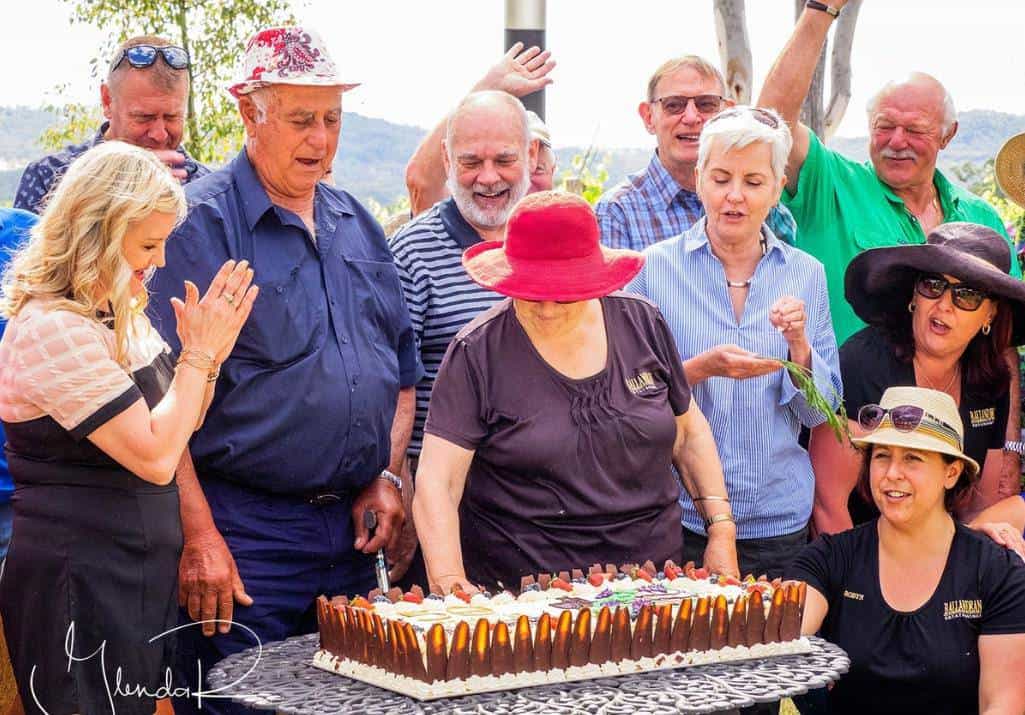
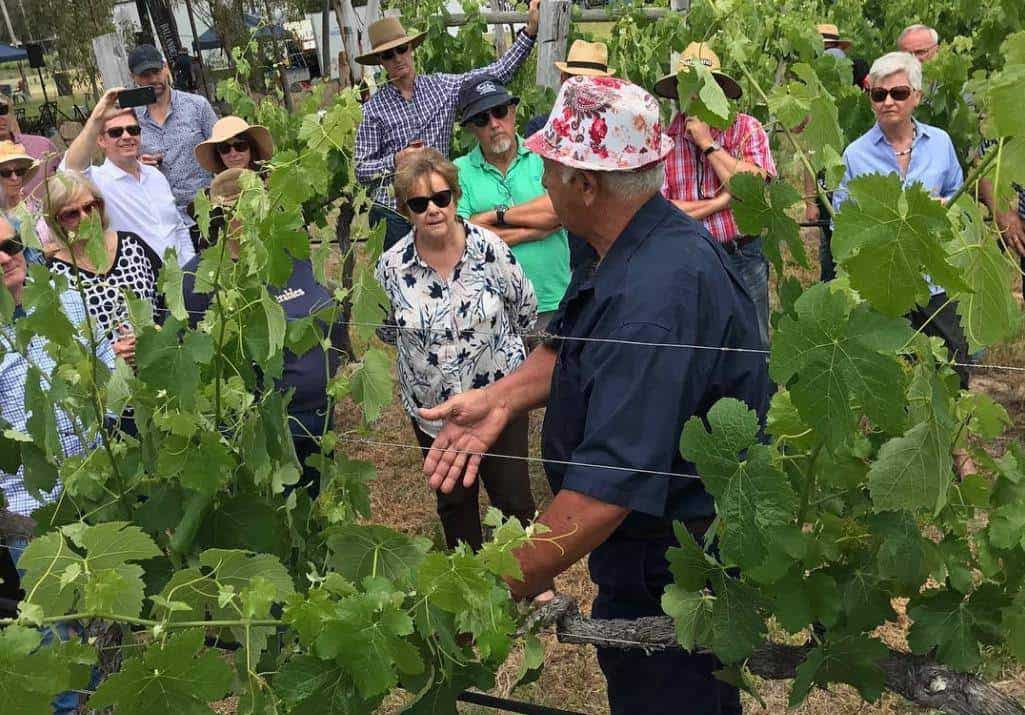
2018 marks 50 years of Shiraz plantings on the Opera Block vineyard at Ballandean Estate, Queensland’s oldest family-owned and -operated winery.
Estate founder Angelo Puglisi had a vision to develop a viable and sustainable commercial wine industry in the Granite Belt region, and in 1968, he planted a block of Shiraz vines with his new wife Mary on his Ballandean farm, cementing the Puglisi winemaking future.
Mr Puglisi’s remarkable vinicultural legacy will be celebrated with a book launch, The Father of the Queensland Wine Industry – Angelo Puglisi, by Tom McSweeny. The biography will be launched on Friday 2 November 2018 at the Stanthorpe Art Gallery at 6pm.
In a nation where most producers pulled up their vines in the late eighties at government behest, this is a remarkable achievement, and testament to the vision of Angelo and Mary Puglisi, pioneers of the wine industry in Queensland.
“Our cool climate Shiraz is a vinicultural jewel. Most Shiraz vines in Australia are under 15 years old—and the older the vines, the lower the yield and more luscious the fruit,” said Angelo Puglisi.
“I am excited to announce the pre-release of our 50th Anniversary 2018 Opera Block Shiraz at our vineyard party on November 10. 2018 was an exceptionally low-yielding year—we have produced only 150 dozen of the Opera Block Shiraz for this vintage. The long ripening season and cold nights have delivered a delicate cool climate Shiraz, intense purple with concentrated berry fruits. We will be bottling this beauty in 2019.”
Angelo’s decision to convert from table grapes to wine grapes was brave and he and Mary worked hard to produce wines of quality and create a market for their Granite Belt grown wines. Those first vines have been lovingly nurtured over the years and now produce the award-winning Opera Block Shiraz—refined, elegant with intense fruit typical of a cool climate profile.
“Mum and Dad were real pioneers, and they dreamed of a Queensland wine industry at such a young age, at just 25 (Angelo) and 19 years (Mary) of age. . Up until the Puglisi’s 1968 Shiraz planting, wine in Queensland was mainly a by-product of table grape production by a few European families who were selling the grapes to market and using the leftovers to make wine. A far cry from the wine grapes of today!
“Visionaries from the start, the Puglisis visualised opening a cellar door and being the catalyst for Queensland’s Barossa and Hunter Valley on the Granite Belt. They knew that wine tourism would follow once there was wine to sell and some more cellar doors in the region. When they opened the cellar door four years after planting the Shiraz, there were only 300 wineries in Australia—now there is over 3300!
“We have been here a long time, since 1932. The 50 years of Shiraz gives legitimacy to the entire Queensland wine industry. I always say that Mum married the Queensland wine industry when she married Dad. Not only are we celebrating 50 years of Shiraz, the Puglisis are celebrating a golden wedding anniversary too, 50 years strong!” says Robyn Puglisi-Henderson, daughter of Angelo and Mary Puglisi.
What’s great about cool climate Shiraz?
First and foremost, it expresses the terroir – the sense of place with the wines, which you don’t always see in warmer climates.
Shiraz grown in warmer climates such as the Barossa ripens more easily, so the wines will typically feature riper fruit flavours, like blackberry and plum, with a lush profile. Cool climate Shiraz wines are more likely to showcase red fruit notes, a peppery, spicy side and a leaner frame. They are gracious, elegant, lower in alcohol and diverse, making cool climate Shiraz an excellent food-matching wine.
Ballandean Estate’s award-winning single vineyard premium Shiraz is sourced from the Opera Block’s oldest vines, planted in 1968, some of the oldest in Australia. Winemaker Dylan Rhymer has delivered a delicate balance of fruit and French oak in the 2015 vintage. This Shiraz is an eloquent demonstration of the Granite Belt’s terroir, boasting ripe berry and cassis aromas. On the palate, intense blackcurrant, light pepper and spices combine with medium tannins for palate structure and a smooth, lingering finish. Aged for 12 to 15 months in air dried French oak barriques; this wine is one of our most consistent award winners.
Australian Shiraz – a survival story
Australia can lay proud claim to the some of the oldest commercial Shiraz vines in the world. We owe this extraordinary vine heritage to our isolated location and quarantine law, as most of the world suffered the ravages of phylloxera, the vine eating louse, in the late 19th and early 20th centuries,
However in the late sixties, the Australian market turned from sweet fortified ports towards table wines—especially Chardonnay. As late as 1989, the Australian government was still paying growers to uproot old Shiraz vines—a travesty! Sadly, many growers unable to sell their Shiraz crops once the taste for sweet fortified ports lapsed in the early seventies lapsed crops would pull up the old vines and replace them with white grapes.
Most Shiraz vines in Australia are young, barely teenagers, with the exception of a few in the warm climate of the Barossa Valley, where a few families with foresight maintained some vines in a time of flux. Did you know that Yalumba was known as the Oporto of Australia? Or that the backbone of Penfold’s Grange is made up of old vine shiraz?
